Art teachers play a vital role in shaping young minds, fostering creativity, and building confidence. Their impact extends far beyond the classroom, nurturing future artists, designers, and thinkers. This guide explores inspiring art teacher quotes, offering insights into the art of teaching art and providing practical strategies for educators. We'll delve into the challenges and rewards, examining how these quotes illuminate the unique aspects of this rewarding profession.
What Makes a Great Art Teacher? A Look at Inspiring Quotes
Many renowned artists and educators have offered profound insights into the teaching process. Their words resonate deeply with art teachers, offering guidance and inspiration. These quotes often highlight the importance of:
-
Encouraging self-expression: "Art is not what you see, but what you make others see." – Edgar Degas. This quote emphasizes the teacher's role in helping students discover their unique artistic voices and perspectives. It's not about replicating what's already there, but about fostering original thought and expression.
-
Fostering creativity: "Creativity is allowing yourself to make mistakes. Art is knowing which ones to keep." – Scott Adams. This highlights the vital role of experimentation and risk-taking in the creative process. A good art teacher creates a safe space for students to explore, even if it means making mistakes along the way.
-
Developing critical thinking: "The aim of art is to represent not the outward appearance of things, but their inward significance." – Aristotle. This quote underscores the importance of going beyond the surface level. Art teachers should encourage students to analyze, interpret, and understand the deeper meaning behind their work and the work of others.
-
Building confidence: "The only way to do great work is to love what you do." – Steve Jobs. Passion is contagious. A teacher's enthusiasm for art can inspire students to develop their own passion and belief in their abilities.
What are the Biggest Challenges Faced by Art Teachers?
While the rewards of teaching art are immense, art teachers also face unique challenges. These often include:
-
Limited Resources: Many art programs struggle with limited funding, impacting the materials available to students. This requires creativity and resourcefulness from teachers to find affordable and effective alternatives.
-
Large Class Sizes: Overcrowded classrooms can make it difficult to provide individual attention and personalized feedback to each student. Innovative teaching strategies and classroom management techniques are essential.
-
Standardized Testing Pressure: The increasing pressure to meet standardized testing requirements can sometimes overshadow the importance of creative exploration and artistic expression. Advocating for the value of arts education is crucial.
-
Balancing Creativity and Structure: Finding the right balance between providing structure and allowing for creative freedom is a delicate task. A good art teacher provides a framework for learning while encouraging experimentation and individuality.
How can I create a positive and engaging art classroom?
Creating a positive and engaging art classroom is paramount to student success. This involves:
-
Establishing a safe and supportive environment: Students need to feel comfortable taking risks and expressing themselves without fear of judgment. Foster a classroom culture of respect and inclusivity.
-
Differentiating instruction: Recognize that students learn at different paces and have varying levels of skill. Provide varied activities and support to meet individual needs.
-
Incorporating technology: Explore the use of technology to enhance learning, such as digital art tools and online resources.
What are some examples of effective art teaching strategies?
Effective art teaching strategies include:
-
Project-based learning: Engage students in longer-term projects that allow for deep exploration of a topic or skill.
-
Collaborative learning: Encourage teamwork and peer learning through group projects and critiques.
-
Inquiry-based learning: Encourage student-led exploration and discovery through open-ended questions and investigations.
How can I inspire creativity in my students?
Inspiring creativity involves:
-
Providing a variety of materials and techniques: Expose students to a wide range of art materials and techniques to broaden their creative possibilities.
-
Encouraging experimentation and risk-taking: Create a classroom culture where students feel comfortable trying new things, even if it means making mistakes.
-
Providing constructive feedback: Offer specific, helpful feedback that encourages growth and improvement.
In conclusion, the role of an art teacher is multifaceted and profoundly impactful. By embracing the wisdom found in inspiring quotes and employing effective teaching strategies, art teachers can create dynamic and enriching learning experiences for their students, nurturing creativity, building confidence, and shaping the next generation of artists.

